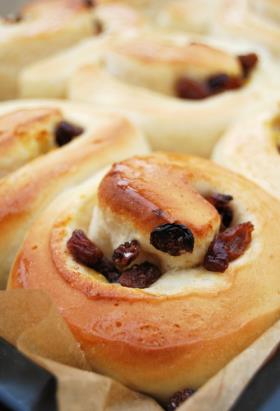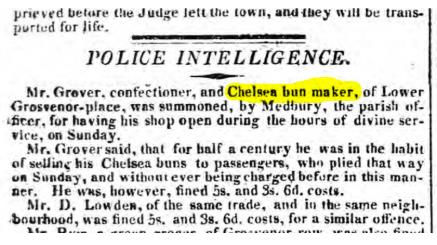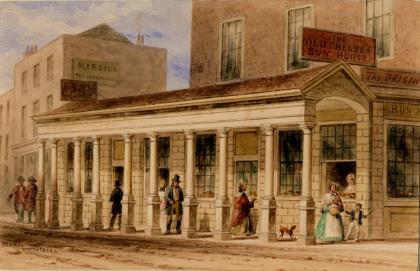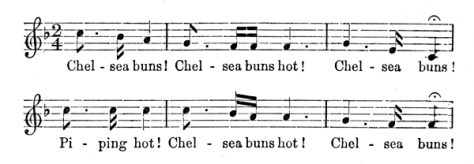

|
 Individual yeast-raised white wheatflour buns, formed of a sheet of dough strewn with currants (or sugar only in earlier receipts, other fruits or nuts in some variants) rolled-up then sliced to create a pin-wheel form typically 5ins diameter and 1in thick. Lightly spiced, usually with cinnamon. Baked close together so as to form a rounded-square shape as they rise. Glazed. Known at least since 1711.  Chelsea Buns Image: 'kochtopf' One noted maker, Fitzbillies of Cambridge, suggests them "gently warmed, with a dollop of ice cream for a truly wicked and unusual dessert."  The crime of selling Chelsea Buns on Sundays Morning Post - Monday 24 March 1823  Original Receipt in 'The complete biscuit and gingerbread baker's assistant', by George Read, 1854 Original Receipt in 'The complete biscuit and gingerbread baker's assistant', by George Read, 1854Chelsea Buns Take plain bun dough, or if they are for common ones bread dough, roll it out in a sheet break some firm butter in small bits and place over it, fold it up and roll it out as you would paste, after you have given it two or three turns moisten the surface of the dough and strew over it some moist sugar, roll up the sheet into a roll and cut it in slices or cut the dough in strips of the required size, and turn them round place them on a buttered tin that has edges about inch from each other prove them well and bake in a moderate oven. You may dust the tops with loaf sugar either before or after they are baked. The quantity of ingredients used must be regulated according to the richness the buns are required 1b of butter and the same quantity of sugar with 4 lbs of dough will make a good bun. When bun dough is used half this quantity of sugar will be sufficient and some omit it altogether. Another 21/2 quarterns of bread dough 1 lb of butter and 1 lb of sugar or 6 oz of butter and 6 oz of sugar to each quartern of bread dough and proceed as before. Now found throughout the Kingdom, the original Old Chelsea Bun House, in the way it seems of 'old original' more-or-less anything in the baking line, wasn't actually in Chelsea but in the neighbouring London borough of Pimlico. It was destroyed by fire in 1839 and used to be visited regularly by George III and Queen Charlotte. J. B. Ellenor, in his 'Rambling Recollections of Chelsea' of 1901, explains more; "The Chelsea Bun Houses - there were two of them - stood on the left side of the Pimlico Road, about one hundred yards beyond the toll-gate by the “Nell Gwynn” tavern. The first one kept at that time by London, had a frontage of at least fifty feet. It was built out fifteen or twenty feet from the house, and had a colonnade in front over the pathway; the other, kept by Chapman, was two doors further on, of the same style but much smaller. On a Good Friday morning I have seen a large crowd waiting to get served, which they did through the window. I have seen carriages and traps waiting as far as the tollhouse."  The Chelsea Bun House Wtercolour by Thomas H. Shepherd (?) about 1850 Jonathan Swift's 'Journal to Stella' of 1711 has "Pray, are not the fine buns sold here in our town; was it not Rrrrrrrrrare Chelsea buns? I bought one to-day in my walk; it cost me a penny; it was stale, and I did not like it". To which his editor, George A. Aitken, adds "The original Chelsea Bun House, in Jew's Row, was pulled down in 1839. Sir R. Philips, writing in 1817, said, "Those buns have afforded a competency, and even wealth, to four generations of the same family; and it is singular that their delicate flavour, lightness, and richness have never been successfully imitated." Dickens mentions them in both 'Barnaby Rudge' and 'Bleak House' and Lewis Carroll's 'A Tangled Tale' has a whole chapter called 'Chelsea Buns', with the line "Give her a Chelsea bun, Miss! That's what most young ladies likes best!" and with a song...   |
|
MORE FROM Foods of England... Cookbooks ● Diary ● Index ● Magic Menu ● Random ● Really English? ● Timeline ● Donate ● English Service ● Food Map of England ● Lost Foods ● Accompaniments ● Biscuits ● Breads ● Cakes and Scones ● Cheeses ● Classic Meals ● Curry Dishes ● Dairy ● Drinks ● Egg Dishes ● Fish ● Fruit ● Fruits & Vegetables ● Game & Offal ● Meat & Meat Dishes ● Pastries and Pies ● Pot Meals ● Poultry ● Preserves & Jams ● Puddings & Sweets ● Sauces and Spicery ● Sausages ● Scones ● Soups ● Sweets and Toffee ● About ... ● Bookshop ● Email: editor@foodsofengland.co.uk COPYRIGHT and ALL RIGHTS RESERVED: © Glyn Hughes 2022 BUILT WITH WHIMBERRY |